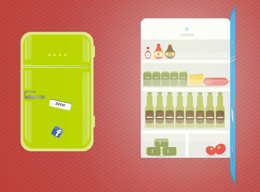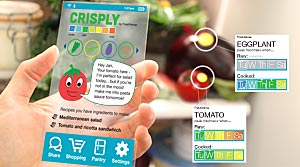Seeds of Disruption
How technology is remaking the future of food
Forecast Perspective: Freshness | Quantifying Peak Flavors
New technologies augment freshness and flavor experiences across the food chain

New technologies in the next decade will give us an unprecedented ability to satisfy our cravings for fresh, flavorful food. Fueled by ubiquitous urban agriculture, new models of food retail, and breakthroughs in the understanding of taste perception, innovations across the food chain will tap into urban spaces, homes, and even our bodies to optimize for freshness and taste. We’ll see a proliferation of what fresh and flavorful can mean—and opportunities to expand markets—as the distance between production and consumption decreases, freshness and convenience become more aligned, and consumer appetites for customized eating experiences grow stronger.
Jump to:
Eating in this Future
Global Signals
Insights
Artifact from the Future
Download
EATING IN THIS FUTURE
- The availability of fresh food expands as urban and home microfarming become more popular and commonplace in cities around the world. At the same time, the effort required to obtain fresh food decreases thanks to advances in refrigeration, new models of local food distribution, and automation of delivery services.
- Sensors that can precisely detect and communicate a food’s freshness ensure that foods are consumed at their peak flavor. Additionally, multisensory technologies that transmit visceral qualities—such as smell—help people gauge freshness at a glance and entice them toward the freshest options.
- Fresh no longer necessarily means natural as it has previously been defined. New technologies significantly augment our ability to grow food in labs when and where we need it. Additionally, technologies induce ripeness in produce and artificially recreate tastes, colors, and textures usually associated with freshness, further blurring these lines.
- How people understand and evaluate freshness changes. Chefs, food companies, and even consumer product designers harness technology and data to become tastemakers, gaming the interaction between our bodies, environment, and food to make eating enjoyable. The ability to engineer for fresh taste by tapping into inedible components renders freshness less important—and, barring freshness sensors, even more difficult to assess.
- In combination, these factors drive new values. Consumers assign different meanings to just-picked, just-made, and just-delivered, creating a new segmented and expanded market for fresh food.
GLOBAL SIGNALS
China
Overcoming Safety Concerns Through Social Proof
 Benlai, which translates to “original,” is an online shop providing fresh produce, fish, poultry, eggs, and milk to affluent residents of Beijing. Designed to overcome food safety concerns over fresh food, Benlai focuses on quality and safety, regularly testing each batch of food. Purchases are kept in cold storage and delivered directly to homes. Buyers contribute shopping experiences and photos of their purchases on the website, pointing toward new ways of using social media to help people verify that their food purchases will be both fresh and safe.
Benlai, which translates to “original,” is an online shop providing fresh produce, fish, poultry, eggs, and milk to affluent residents of Beijing. Designed to overcome food safety concerns over fresh food, Benlai focuses on quality and safety, regularly testing each batch of food. Purchases are kept in cold storage and delivered directly to homes. Buyers contribute shopping experiences and photos of their purchases on the website, pointing toward new ways of using social media to help people verify that their food purchases will be both fresh and safe.
Source: Dong, C. Benlai.com: B2C eCommerce Site Selling Safe and Healthy Food. TechNode. September 14, 2012. http://technode.com/2012/09/14/benlai-com-b2c-ecommerce-site-selling-safe-and-healthy-food/
United States
Creating Dynamic New Metrics of Freshness
 At Central Market—a one-stop grocery store, cooking school, and cafe chain in Texas—bananas are organized according to estimated freshness. Shoppers are prompted to anticipate when they will actually consume their purchase, introducing consideration of time and freshness preferences into the food purchase decision process. Unlike shelves of food with expiration labels, the more subjective banana display invites both store employees and shoppers to assess freshness based on sensory cues. With the advent of sensors, similar displays will become standard and usher in a new set of metrics and designs based on which foods have achieved peak freshness for specific uses, rather than simply whether or not food has expired.
At Central Market—a one-stop grocery store, cooking school, and cafe chain in Texas—bananas are organized according to estimated freshness. Shoppers are prompted to anticipate when they will actually consume their purchase, introducing consideration of time and freshness preferences into the food purchase decision process. Unlike shelves of food with expiration labels, the more subjective banana display invites both store employees and shoppers to assess freshness based on sensory cues. With the advent of sensors, similar displays will become standard and usher in a new set of metrics and designs based on which foods have achieved peak freshness for specific uses, rather than simply whether or not food has expired.
Source: Central Market: Really Into Food. centralmarket.com.
Scandanavia
Using Purchase Data to Track the Freshness of Foods in Refrigerators
 Food Fight is a concept for a mobile app developed by students at the Miami Ad School Europe for the ICA Supermarket chain in Scandanavia. The prototype would leverage a user’s purchase history from the ICA Supermarket to determine what items might be in their fridge and when they expire. The app would alert users when food items are set to expire, then suggest recipes that could be made with the items or places to donate the food. Food Fight is designed to integrate social elements, allowing users to broadcast soon-to-be expired foods to others nearby who might want to take them.
Food Fight is a concept for a mobile app developed by students at the Miami Ad School Europe for the ICA Supermarket chain in Scandanavia. The prototype would leverage a user’s purchase history from the ICA Supermarket to determine what items might be in their fridge and when they expire. The app would alert users when food items are set to expire, then suggest recipes that could be made with the items or places to donate the food. Food Fight is designed to integrate social elements, allowing users to broadcast soon-to-be expired foods to others nearby who might want to take them.
Source: Ahlen, C. Food Fight—Fight Against Food Waste. 2013. vimeo.com/61700780.
INSIGHTS
Sensors create new metrics of freshness
As new technologies give high-resolution views of the freshness of different foods, our binary systems—of whether or not food has expired—will be replaced by a much more fine-grained system of freshness metrics. Designed not only to convey pure freshness but also to give people insights into when different foods are at their peak for different kinds of uses, these shifts will create quantitative metrics that shift how people perceive the freshness of their food choices.
Confusion creates new opportunities for education and services beyond the store
As new kinds of freshness metrics emerge, they will create as many questions as answers for individuals looking to buy the highest quality ingredients. Initiatives such as the Food Fight app point toward opportunities to develop services that expand the role of retailers out beyond the retail store while simultaneously helping people make sense of new kinds of freshness scores.
Social dynamics shape perceptions
In places, such as China, where food safety issues remain a major concern, perceptions of freshness will be shaped by objective metrics as well as social media. Integrating freshness efforts that couple sensors and other advanced technological measurements with social tools will enable friends and networks to collectively make sense of how to understand freshness and safety within broader contexts.
ARTIFACT FROM THE FUTURE
New Metrics at the Butcher
 What: Your fridge always used to have a few of those notorious tomatoes—the ones whose skin is just starting to shrivel. You knew you should eat them, but always passed them up for fresher looking alternatives until it was too late. But now you can’t ignore them! It is that tomato’s dying wish to be consumed at peak freshness, and Crisply won’t let you forget it. So far it’s working! You’re throwing out less produce while also branching out to try new recipes.
What: Your fridge always used to have a few of those notorious tomatoes—the ones whose skin is just starting to shrivel. You knew you should eat them, but always passed them up for fresher looking alternatives until it was too late. But now you can’t ignore them! It is that tomato’s dying wish to be consumed at peak freshness, and Crisply won’t let you forget it. So far it’s working! You’re throwing out less produce while also branching out to try new recipes.
So What: Freshness-sensing packaging and produce stickers will provide more precise expiry information than traditional “best by” labels. However, this information has the potential to overload consumers with metrics and considerations that don’t help them make decisions. To truly make this information actionable, people will need solutions that make interacting with the new data intuitive and enjoyable.
Download:
- SUSTAINABILITY Forecast Perspective (PDF)
- Artifact from the Future - New Metrics at the Butcher (JPG)